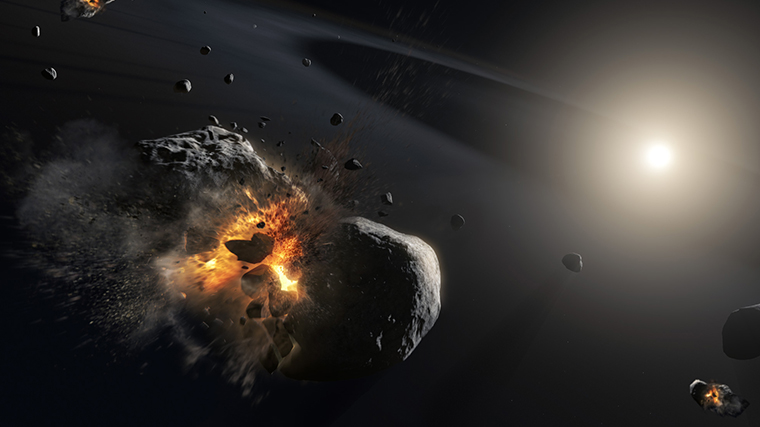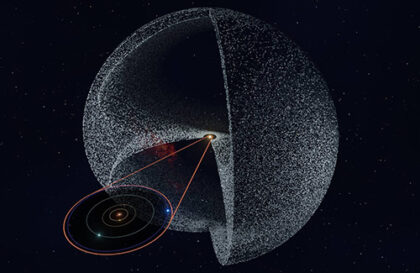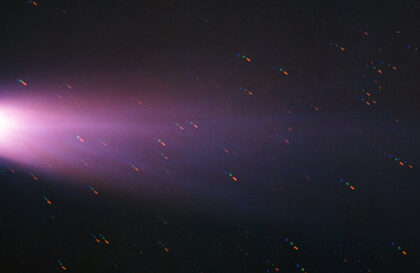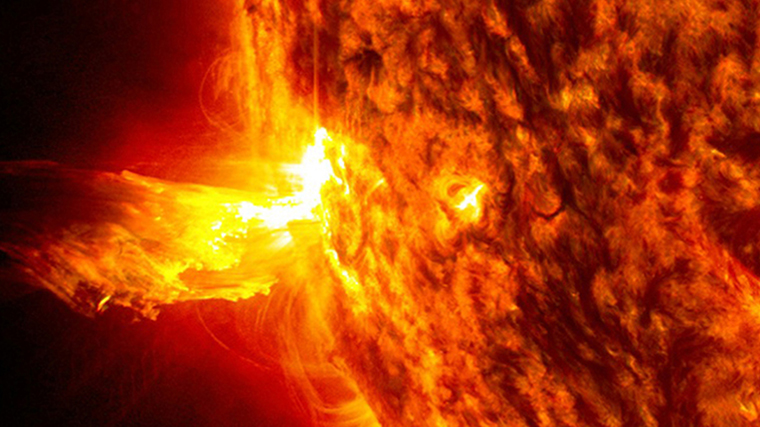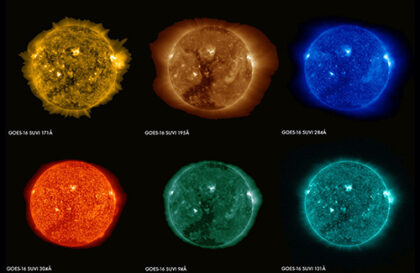Even 40 years ago, the formation of planets was considered an orderly process. It is now known that this is a chaotic process. Planets begin to form when a star is 1-3 million years old.
Born planets are those who survived, the rest were absorbed by the Sun, their fellows, or thrown into space.
There are conditional 7 stages of the formation of planets, at each of which something could go wrong and only one planet remained in the Solar System – Mega-Earth.
Stage 1. Particles collide, stick together, and grow
How does it all begin?
Everything begins 1-3 million years after the formation of a star and, as always, with collisions. Small particles collide, stick together, and grow. Planetesimals are formed – the building blocks of planets. Those that are larger than a millimeter slow down and spiral toward the star. In the so-called Frost line between Mars and Jupiter, particles tend to stick together and easily combine into larger bodies – planetesimals. The larger they become, the faster they move in the direction of the Sun. Meter-sized globs can halve their distance from the star in just 1,000 years.
Frost line
The Frost line divides the planetary system into an inner region devoid of volatile substances and containing solid bodies, and an outer region rich in volatile substances and containing icy bodies. It also creates a pressure jump that prevents particles from entering the inner region. Material accumulates in the outer region, sticks together in lumps, and some of them manage to break through to the inner region. At the Frost line, the ice melts and makes the particles stickier.
Gradually, dust particles gather into kilometer-sized bodies called planetesimals, which at the last stage of planet formation rake up almost all the primary dust.
As a result, many kilometer-long “building blocks” called planetesimals are formed.
What could have gone wrong in the 1st stage?
The protoplanetary disk could turn out to be loose, lacking enough material. As a result, zero planets. They have nothing to form.
Or the Frost line was formed after the appearance of the super-earth, i.e. a planet that is larger than Earth but smaller than Neptune.
Stage 2. Birth of “oligarchs”
Struggle for substance
Billions of kilometer-sized planetesimals assemble into bodies the size of the Moon or the Earth, called embryos. Those who dominate in their orbital zones are “oligarchs”. They fight for the remaining substance. Potentially, only one can emerge as the winner. This stage lasts 1-10 million years.
The cratered surfaces of Mercury, the Moon, and asteroids leave no doubt that during the period of formation, the planetary systems resembled a shooting range. Mutual collisions of planetesimals can lead to their growth or destruction.
The largest begin to use their gravity. The feeding zone of each embryo is a narrow strip along its orbit. The size of the zone and the duration of absorption increase with distance from the star. At a distance of 1 a.u. the embryos reach a mass of 0.1 Earth mass within 100,000 years. years At a distance of 5 a.u. they reach four Earth masses in a few million years. Nuclei can become even larger near the Frost line or at the edges of disk breaks, where planetesimals are concentrated.
As a result, the embryos of the planets are formed.
What could have gone wrong in the 2nd stage?
Not 8, but fewer large embryos (future planets) could have formed. There could well be fewer planets in the Solar System. Could it be more? Hardly.
Stage 3. Formation of gas giants
Formation of Jupiter
In the same period, a gas giant like Jupiter can form. Then he begins to control the entire system. In 1000 years, a Jupiter-type planet gains half of its final mass. Then it grows for another 10 million years. At the same time, it emits so much heat that it shines almost like the Sun. And if it gains even more mass in 1000 years, the probability of one planet in the system increases.
If such a planet is formed, it begins to control the entire system.
For this to happen, everything must happen quickly. The embryo must collect gas faster than it spirals toward the center. The formation of a giant planet is hindered by waves that excite in the surrounding gas. The action of these waves slows down the planet and causes it to migrate toward the star. The planet attracts gas, but it cannot settle until it cools. During this time, it can spiral quite close to the star. Therefore, a giant planet may not form in all systems.
Probably, Jupiter began with an embryo comparable in size to the Earth and then accumulated about 300 Earth masses of gas. The bottleneck is the cooling rate of the planet so that the gas has time to cool and settle. Otherwise, the star will blow the ego back into the disc. The nucleus of a planet must have a mass of at least 10 Earth masses for sufficiently rapid cooling. Such a large specimen can grow only near the Frost line, where a lot of matter has previously been collected. Perhaps, that is why Jupiter is located just behind this line.
Saturn has less mass than Jupiter, simply because it was formed several million years later.
The result of this stage is the presence or absence of a planet the size of Jupiter.
What could go wrong in the 3rd stage?
The accelerated growth of the giant planet, vacuums up the substance of the protoplanetary disk very quickly, leaving no chance for the second. As a result, there could be one planet in the solar system.
Astronomers have discovered a shortage of planets with masses from 20 Earth masses (that is the mass of Neptune) to 100 Earth masses (the mass of Saturn). It’s strange.
Stage 4. The gas giant becomes restless
Migration of the gas giant
A gas giant is formed in the inner part of the planetary system, competing with rocky planets, near the Frost line, while there is still enough gas and a lot of solid matter in the disk. Then he moves to the place of his current location. When the giant moves, it pushes the remaining planetesimals and embryos in front of it, possibly creating a “hot Earth” in orbits even closer to the star.
But what can stop his motion to the star?
This may be the magnetic field of the star, which clears the space near the star of gas, and without gas, the movement stops. It is possible that the planet excites tides on the star, and they, in turn, slow down the fall of the planet and even throw it further, beyond the Frost line.
If one gas giant manages to form, then it contributes to the birth of the next giant. This is provided that there is a sufficient amount of material. Many, and possibly most, of the known giant planets have twins of comparable mass.
The result: a giant planet in a close orbit (“hot Jupiter”) or the familiar giant Jupiter.
At this time, other giant planets also appear. For example, Saturn.
What can go wrong in the 4th stage?
The star will eat all the material of the disk that has come dangerously close to it. In this case, there will be no planets.
Or a giant, migrating along the planetary disk, absorbs all matter and becomes a monopolist.
Stage 5. The second generation of planets
Formation of outer planets
The second generation of planets is formed from the material collected for them by the first gas giant. The strip cleared by it acts as a moat, which the substance moving from the outside to the center of the disk cannot overcome. It collects on the outer side of the gap, where new planets are formed from it.
At the same time, tempo is very important: even a small delay in time can significantly change the result. In the case of Uranus and Neptune, the accumulation of planetesimals was excessive. The embryos became too large, 10–20 Earth masses. But these are no longer gas, but ice giants, which may turn out to be the most common type of planets in the Universe.
Outer planets wreak havoc
Gravitational fields of second-generation planets increase chaos in the system. If they formed too close, their interaction with each other and with the gas disk can throw them into higher elliptical orbits.
In the Solar System, the planets have almost circular orbits and are sufficiently distant from each other that their mutual influence is reduced. It wasn’t always like that.
What could go wrong in the 5th stage?
Planets can form not in the plane of the orbital motion of stars, like our Solar System, but surround the star in the form of a sphere, like the Oort cloud, resembling a swarm of bees around a beehive.
Stage 6. Earth-type planets are formed
Inside the Frost line
The birth of a gas giant requires an exact balance of competing processes, the formation of a solid planet should be much more complicated.
The four planets of the terrestrial group—Mercury, Venus, Earth, and Mars—mainly consist of substances with a high boiling point, such as iron and silicate rocks. So they formed inside the Frost line and did not migrate noticeably.
At such distances from the star, the embryos of the planets can grow no larger than Mercury. For further growth, the orbits of the embryos must intersect, then they will collide and merge. He got the land in childhood.
When the planets have almost formed, there is still a decent swarm of planetesimals. During the next 100 million years, the planets sweep away some of these planetesimals, and the rest are deflected towards the Sun. The planets transmit their erratic motion to the doomed planetesimals and move into circular or nearly circular orbits.
Influence of Jupiter
According to the second idea, the long-term influence of Jupiter’s gravity causes the forming planets of the terrestrial group to migrate, moving them to areas with fresh matter. Radioisotope measurements indicate that asteroids formed first 4 million years after the formation of the Sun, Mars 10 million years later, and Earth 50 million years later: as if a wave of matter raised by Jupiter passed through the Solar System. If it had not encountered obstacles, it would have moved all the planets of the terrestrial group to the orbit of Mercury.
How did they manage to avoid such a sad fate?
Perhaps they had already become too massive and Jupiter could not move them much, or perhaps strong impacts threw them out of Jupiter’s range.
Be that as it may, and as a result, terrestrial-type planets are formed.
What could go wrong in the 6th stage?
If Jupiter did not have time to form in the previous stages, then inside the Frost line there will be many small Mercurys.
In our case, Jupiter and the Sun shared a “lunch” between themselves.
Stage 7. Cleaning operation
This stage occupies a period from 50 million to 1 billion years.
By the star’s 50 millionth anniversary, the planetary system has almost formed. But the disintegration of the surrounding star cluster, capable of destabilizing the orbits of the planets with its gravity, continues. The internal instability continues the scattering of the remaining planetesimals by the giant planet.
In the Solar System, Uranus and Neptune throw planetesimals outward, into the Kuiper belt, or toward the Sun. And Jupiter with its powerful gravity sends them to the Oort cloud, to the very edge of the area of the Sun’s gravitational influence. The Oort cloud can currently contain about 100 Earth masses of matter. This is another 100 Earth planets. From time to time, planetesimals from the Kuiper belt or the Oort cloud approach the Sun, forming comets.
Scattering planetesimals, the planets themselves migrate a little. In some systems, grandiose collisions of formed planets can occur even at a late stage of development.
The result is a formed planetary system.
What can go wrong in the 7th stage?
Grand clashes continue, which will maintain chaos for a long time to come. But the winner or winners will certainly appear.
It is important that any stage can become the key for the “All planets in one” scenario.
Examples of stars with one planet
Vega
Vega is the only super-hot planet with the mass of Neptune, and maybe even Jupiter.
A hypothetical exoplanet makes one revolution around its sun in less than 2.5 Earth days. This means that it is located very close to the star. So close that it must be heated to almost 3000 °C. This temperature is typical for red dwarfs – the most common type of stars in the universe.
GJ 367b
GJ 367b orbits a red dwarf located about 31 light years from Earth. The diameter of the planet is just over 9 thousand km (the diameter of the Earth is 12.7 km), while GJ 367b weighs half as much as the Earth. This has become a mystery to scientists – the exoplanet is closer in size and mass to Earth, but in composition, it is more similar to Mercury, which is almost entirely composed of iron.
The temperature on the planet’s surface can reach almost 1500 °C. This is enough to melt stone and metal, and therefore the entire planet is most likely a continuous world of lava.
b Centauri b
The planet is located near the star system Beta Centauri, the second brightest in the constellation Centaurus. The discovered exoplanet is 10 times larger than Jupiter, making it one of the most massive planets scientists have ever discovered.
In addition, b Centauri b moves around the star system in one of the widest orbits at a distance of 100 times the distance from Jupiter to the Sun.
Image credit:
https://news.arizona.edu
https://www.astronomy.com
https://archive.briankoberlein.com
https://sci.esa.int
https://www.forbes.com
https://www.universetoday.com
https://www.nasa.gov
